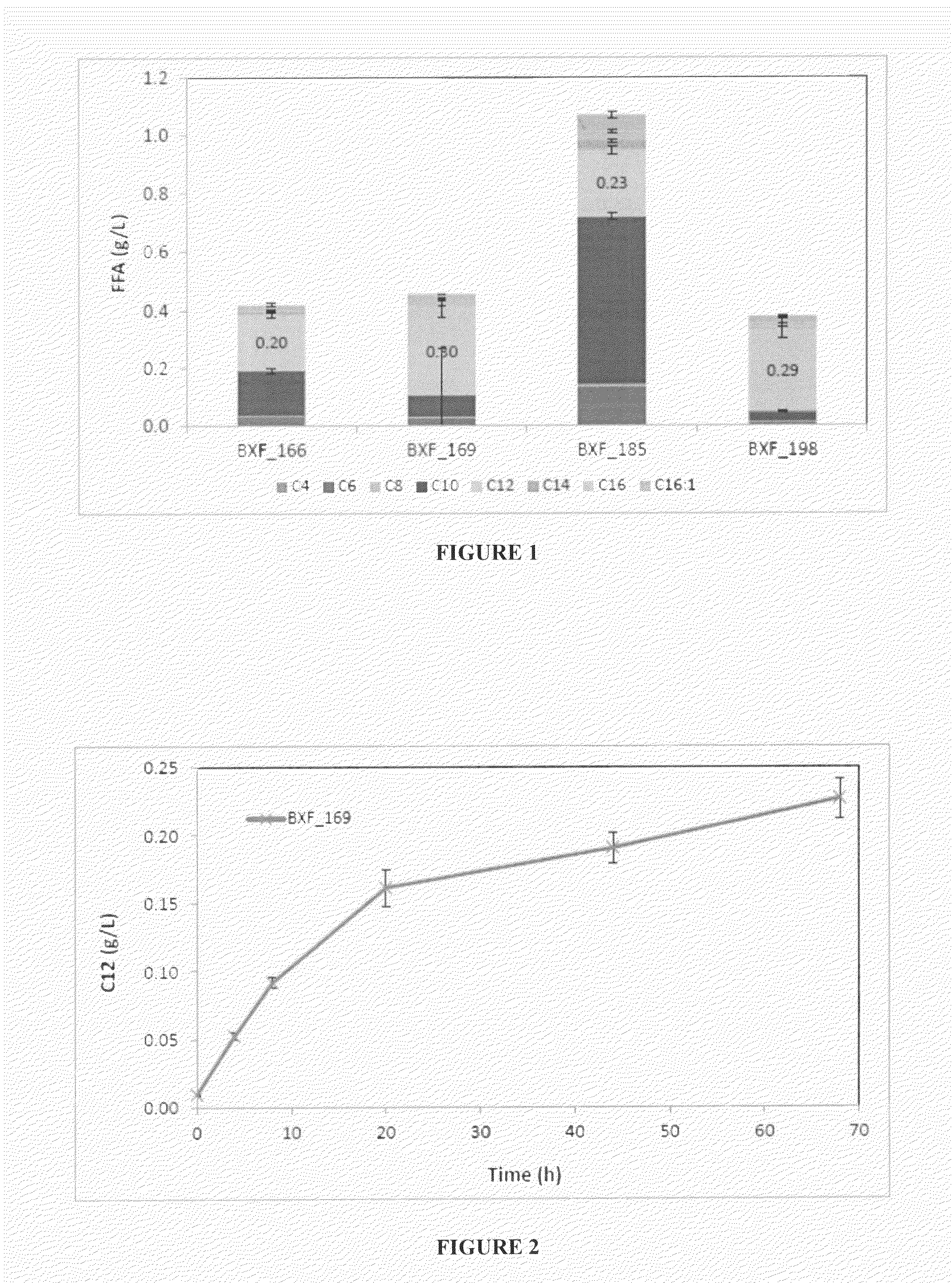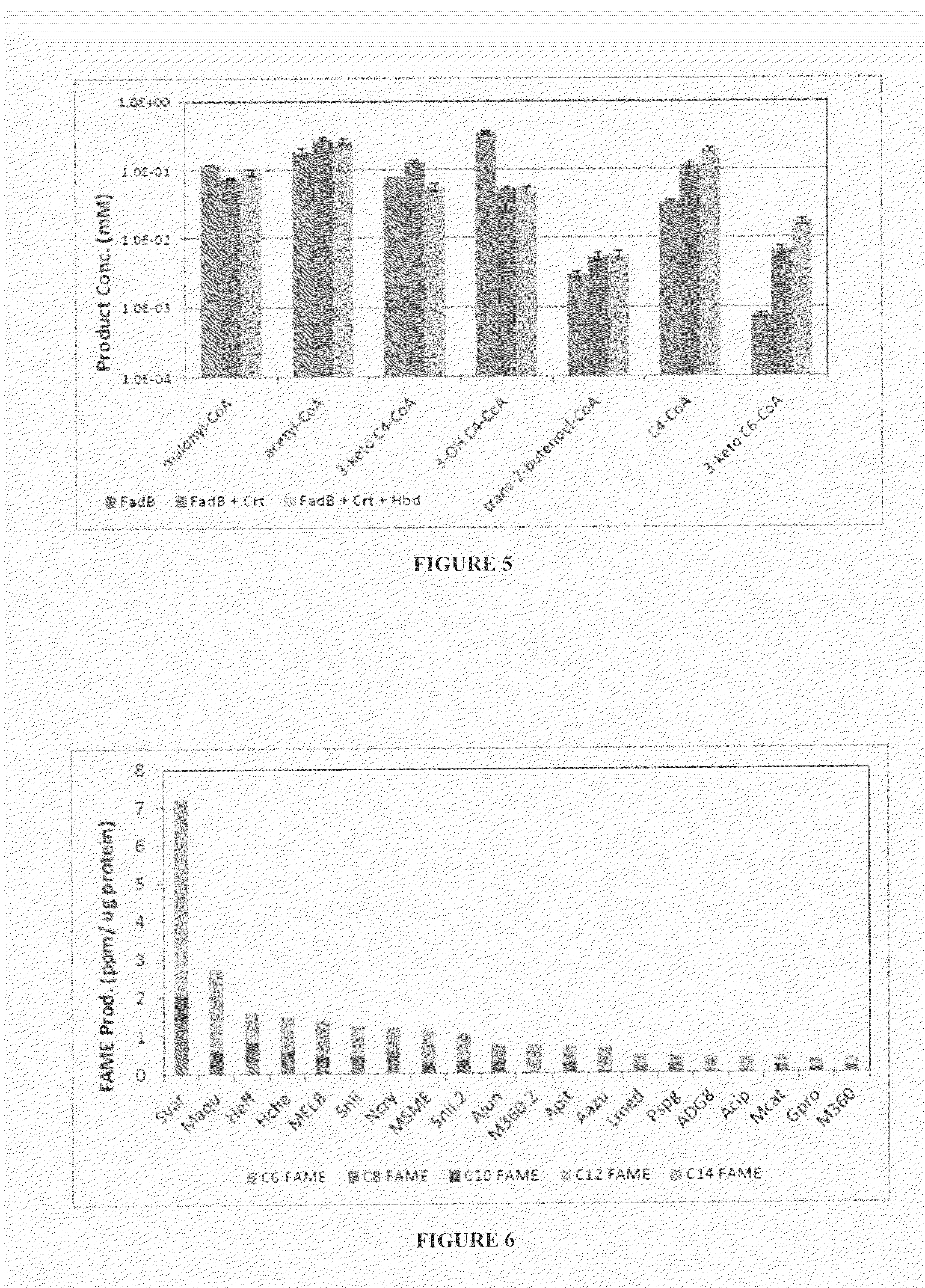Production of fatty acids esters
- Summary
- Abstract
- Description
- Claims
- Application Information
AI Technical Summary
Benefits of technology
Problems solved by technology
Method used
Image
Examples
example 1
Optimization of C12 Fatty Acyl-CoA Production in E. coli Production of Fatty Acids Via Malonyl-CoA and Acetyl-CoA in a Shake Flask Experiment
[0105]
TABLE 4aList of microorganism strains that were used to produce fatty acids in the subsequent examples. The method of production and the sequences of the strains are provided in Table 3.2 of WO2014026162A1 (OPX Biotechnologies Inc., USA).StrainSEQ ID designationHostPlasmidNOs.BXF_0012BX_8641) pBMT-3_ccdAB30BXF_0013BX_8641) pBMT-3_ccdAB_PT7-31′tesABXF_0014BX_8641) pBMT-3_ccdAB_PT7-32nphT7-hbd-crt-terBXF_0015BX_8641) pBMT-3_ccdAB_PT7-33′tesA_PT7-nphT7-hbd-crt- terBXF_0018BX_864pBMT-3_ccdAB_PT7-32nphT7-hbd-crt-terBXF_0020BX_8601) pBMT-3_ccdAB_PT7-33′tesA_PT7-nphT7-hbd-crt-terBXF_0021BX_8761) pBMT-3_ccdAB_PT7-33′tesA_PT7-nphT7-hbd-crt- terBXF_0022BX_8741) pBMT-3_ccdAB30BXF_0023BX_8741) pBMT-3_ccdAB_PT7-31′tesABXF_0024BX_8741) pBMT-3_ccdAB_PT7-33′tesA_PT7-nphT7-hbd-crt- terBXF_0025BX_8751) pBMT-3_ccdAB30BXF_0026BX_8751) pBMT-3_ccdAB_PT7-31′tes...
example 2
Optimization of Wax Ester Synthase (WES) Activity for Methyl Laurate Production
[0119]WES candidates were expressed, purified, and evaluated for solubility and FAME production in vitro. Based on the results of the initial screen, 21 WES candidates were chosen for further evaluation including substrate specificity and in vivo FAME production. In vitro assays were completed by measuring product formation following the addition of individual CoA substrates. As summarized in FIG. 6, a range of activities was observed on the various substrates and a number of candidates were identified based on high overall activity (Svar, Maqu) or specificity for substrates >C12-CoA (M360.2, Acip). The sequences of the WES used are provided in Table 1 above.
[0120]As an orthogonal method for testing in vivo activity, nine of the WES candidates (Table 4f) shown to be active on lauroyl-CoA in the presence of methanol were expressed in a fatty acid production host.
TABLE 4fNine WES candidates shown to be acti...
example 3
Construction and Evaluation of Methyl Laurate Producing Strains
Engineering of Strains for Methyl Laurate Production
[0125]Numerous methyl laurate production strains have been constructed, incorporating key pathway modules developed in Examples 1 and 2 above and building upon the malonyl-CoA production technology as described in W02014026162A1 (OPX Biotechnologies Inc., USA). Small-scale evaluations were completed for each strain cultured at OD600=2.0 in a 20 mL capped glass test tube with a working volume of 1 mL. Samples were taken at 24 hours by extracting the entire culture with MTBE and analyzing for FAME production by GC-MS. This 1 mL protocol was instituted in an effort to reduce volatile loss of FAME products seen during shake flask evaluations.
TABLE 5methyl laurate production strains used in Example 3BaseStrain #strainPlasmid 1Plamid 2BXE_233BX_1018pET_PpstsIH-Aagr-PtpiA-pACYC-PpstsIH-nphT7accDA-PrpiA-accB-accC(SV)-ter-PpstsIH-fadB-PphoE-MhydBXE_275BX_1018pET_PpstsIH-Aagr-Ptp...
PUM
| Property | Measurement | Unit |
|---|---|---|
| Fraction | aaaaa | aaaaa |
| Fraction | aaaaa | aaaaa |
| Degradation properties | aaaaa | aaaaa |
Abstract
Description
Claims
Application Information
 Login to View More
Login to View More - R&D
- Intellectual Property
- Life Sciences
- Materials
- Tech Scout
- Unparalleled Data Quality
- Higher Quality Content
- 60% Fewer Hallucinations
Browse by: Latest US Patents, China's latest patents, Technical Efficacy Thesaurus, Application Domain, Technology Topic, Popular Technical Reports.
© 2025 PatSnap. All rights reserved.Legal|Privacy policy|Modern Slavery Act Transparency Statement|Sitemap|About US| Contact US: help@patsnap.com



